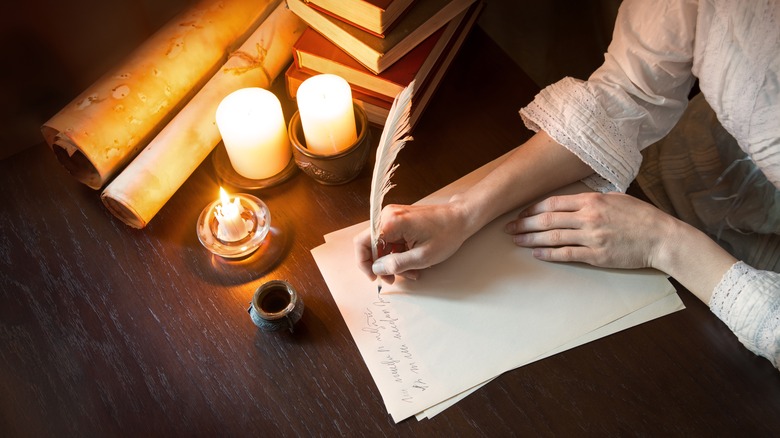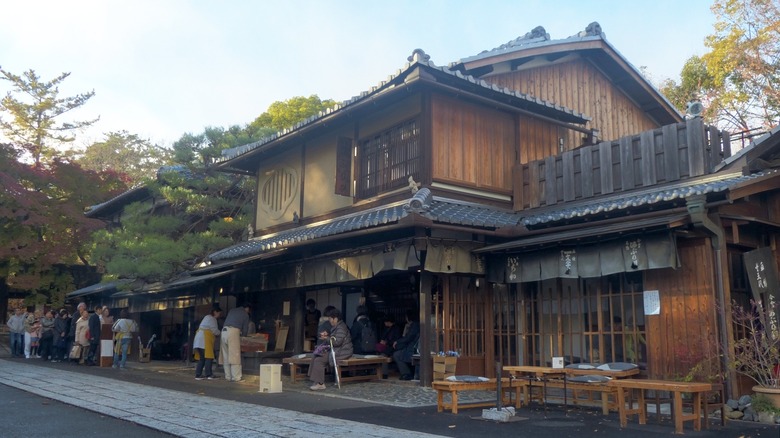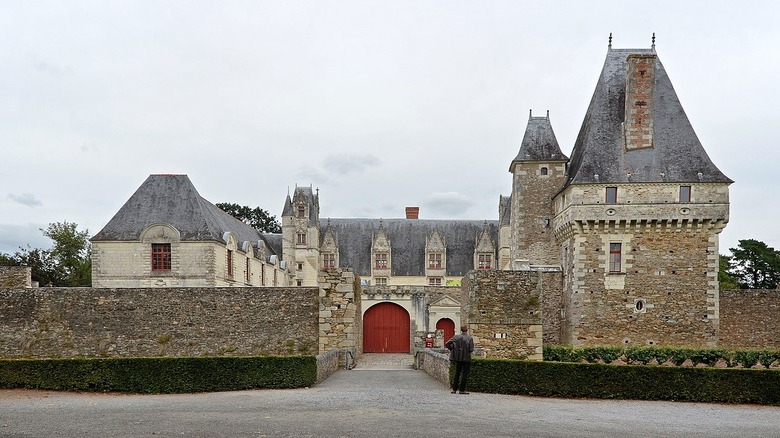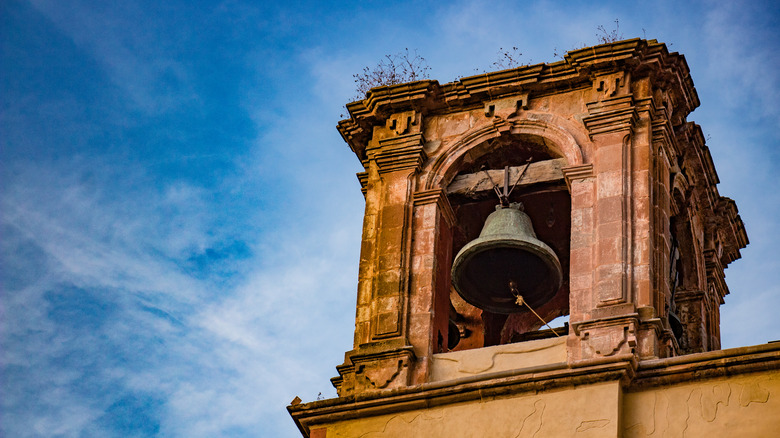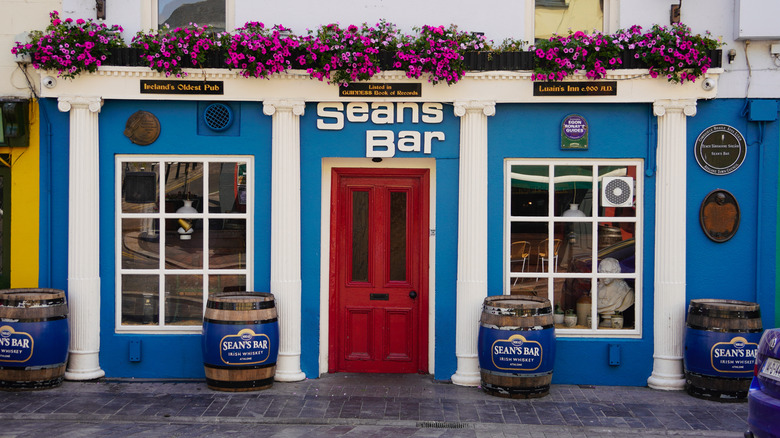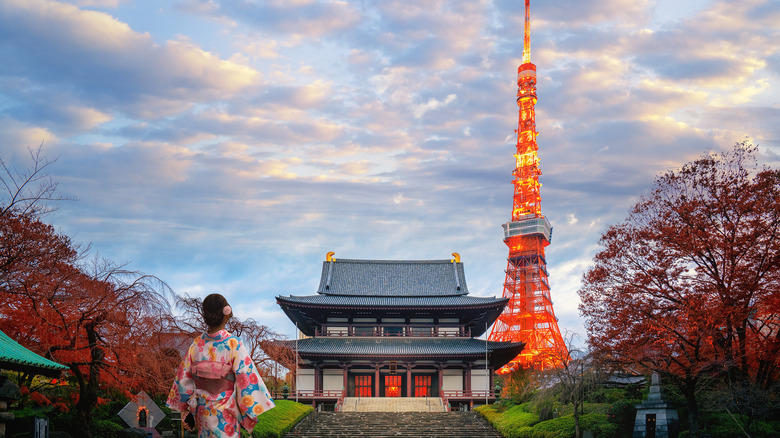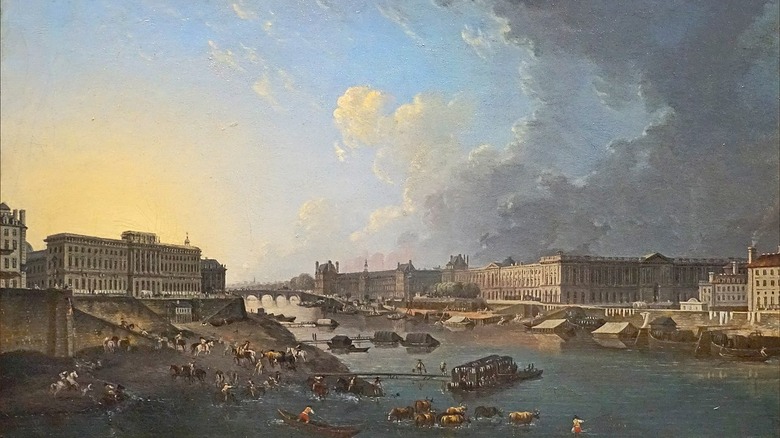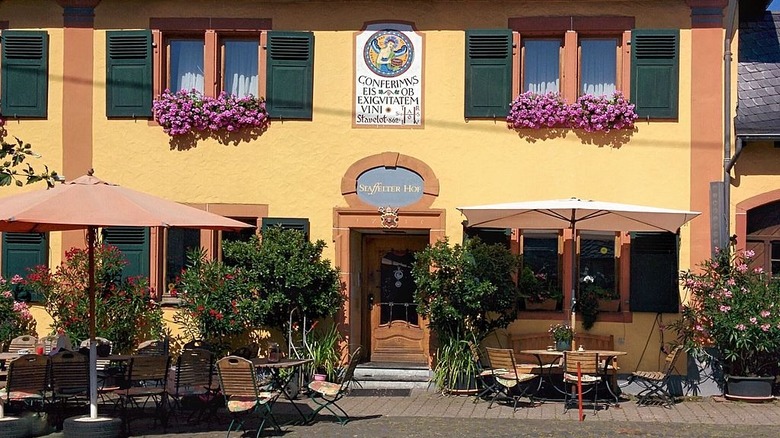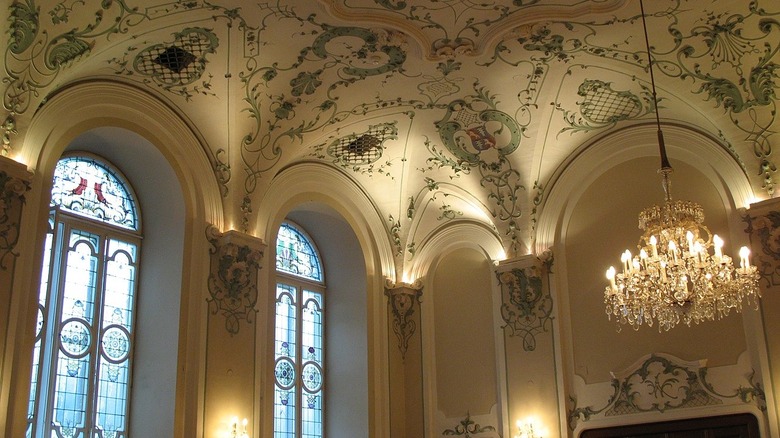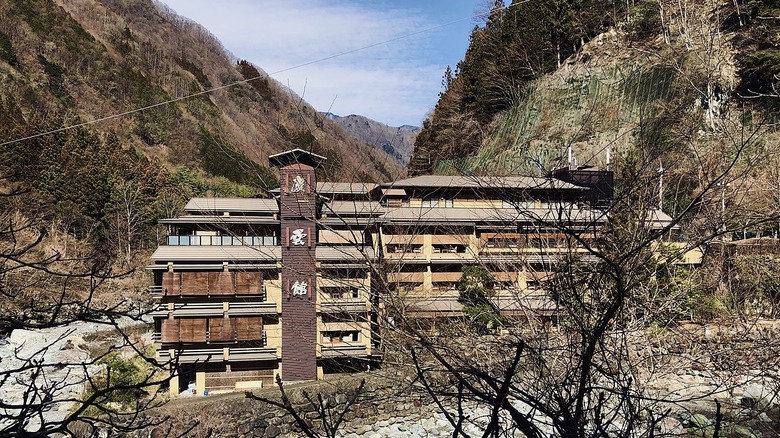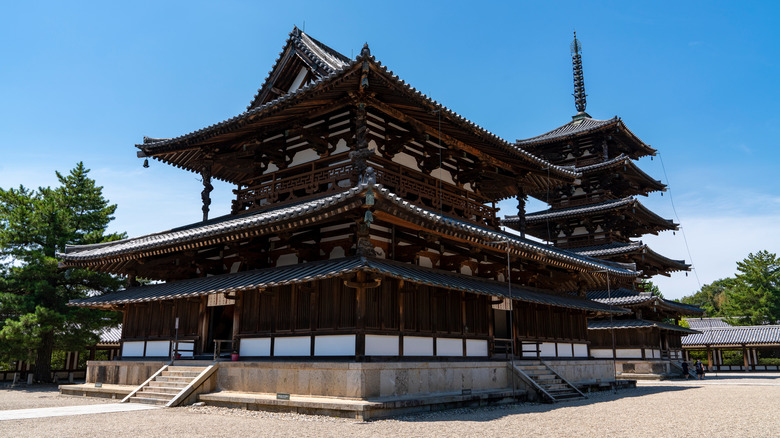Companies That Have Been In Business For More Than 1,000 Years
Longevity in business has been written about extensively in recent years. As Forbes explains, only 30% of new businesses survive for 10 or more years. In other words, a typical housecat is likely to live longer than most startups. The prospect of remaining in business long-term, and reaping the benefits of being established, is a goal of any budding entrepreneur. Amid the noise and rush of the modern world, perhaps they'd do well to look to the past for inspiration.
According to Investopedia, the rise of capitalism took shape in the 18th and 19th centuries, following the colonial mindset of conquest and extracting resources — and it changed the way the world worked, as countries started to industrialize. This model, with emphasis on continual growth and expansion, still dominates in modern business, but it seems to work well for only a select few large companies. In the 21st century, as the IMD notes, most companies can barely expect to live two decades. In the 1950s, a company could last for around 60 years, but those life expectancies have fallen steadily. Per Statista, the number hit its low point in 2001, when companies had a typical life expectancy of only 13.8 years.
So it may come as something of a surprise to learn there are a handful of companies that have lasted for more than 1,000 years, making them much older than capitalism itself.
Ichimonjiya Wasuke (est. circa A.D. 1000)
The world's oldest sweet shop can be found in Kyoto, Japan, where it has been for around 1,000 years. Listed by Guinness World Records, its name is Ichimonjiya Wasuke (一文字屋和輔). The locals affectionately call it Ichiwa, and it has been serving visitors throughout the past millennium. According to Atlas Obscura, the specialty at Ichiwa is aburi-mochi, a kind of roasted rice cake seasoned with ground soybeans and served with a sweet white miso sauce. The book "Old Kyoto: A Guide to Traditional Shops, Restaurants, and Inns" elaborates that the aburi-mochi made at Ichiwa are quite labor-intensive. Each charcoal-grilled rice cake uses a handmade skewer, split from green bamboo stalks (when time permits), with each serving requiring 16 skewers. In many ways, the sweet treats served are little changed from the ones prepared here a millennium ago.
The place was originally founded to serve refreshments to travelers arriving to visit the nearby Imamiya shrine, which also traditionally serves aburi-mochi during festivals. At the time, it was believed that by offering bamboo skewers at the shrine, the gods could provide people with protection from disease. Ichiwa is housed in several buildings today, the oldest of which dates back to the 17th century, and one includes a medieval well that the shop once used regularly.
Château de Goulaine (est. circa A.D. 1000)
Wine is one of France's best-known products, and the tradition goes back a long, long time. The oldest vineyard in France has been producing wine for around a millennium, based in the Loire Valley, just outside Nantes. Its name is Château de Goulaine, built by the Goulaine family in the Middle Ages. The original castle was built in the 13th century but was replaced in the 15th century, featuring Renaissance architecture for which France is renowned. All the while, wine has been made at the Goulaine estate, in a tradition older than either castle. Goulaine wines have a proud history — they've been enjoyed by, among others, two of France's most famous monarchs, Henry IV and Louis XIV, both of whom stayed at the château.
It's uncertain exactly when the Goulaine estate started producing wine commercially, rather than just for family members to enjoy. But according to The Drinks Business, it's clear that the estate has been producing wine since at least A.D. 1000, and it has outlasted all of its neighbors. Today, Château de Goulaine is among the last châteaux in the Loire Valley still producing wine.
Pontifica Fonderia Marinelli (est. circa A.D. 1000)
Pontifica Fonderia Marinelli is the oldest foundry in the world. Its main product is bells, and the firm proudly states that its first was cast in approximately the year 1000. Fonderia Marinelli constructed bells for churches all around Italy, including several famous locations. Today, Marinelli bells can be found at Montecassino Abbey in Cassino and St. Peter's Basilica in Rome (via Lonely Planet).
The company is based in a village in the mountain town of Molise, which is known locally as the "town of the bells," according to Italia su misura. It has been using the same forge for centuries to make bells and bronze sculptures, featuring the same ancient technique since the beginning. Known as lost-wax casting, it starts with the creation of a wax model of the intended object, Britannica explained. A mold is made from the wax sculpture, and the wax is melted down, leaving the interior hollow. Finally, the mold is used to cast the finished metal object. The Marinelli family has reportedly been using this art since the dawn of its bell business, passing the technique down through the generations.
Sean's Bar (est. circa A.D. 900)
The age of Sean's Bar in Athlone, Ireland, was a surprise to its current owner when he acquired it. Believed to have been established around A.D. 900, it's been officially recognized as the oldest public house in Ireland, and possibly the world. In 1970, when the pub was undergoing renovations, a closer look at the materials used in the walls' construction helped pinpoint the facility's age. The ancient methods used to build the walls include a kind of basket weave for added strength, described by BBC Travel as "wattle and wicker," interwoven with horse hair and clay. Experts dated the walls back to the ninth century, prompting the owner to spend parts of three decades researching the full history of the place. Some portions of the old walls are still on display for visitors to see.
Sean Fitzsimons bought the establishment in 1968, completely unaware of its deep legacy. He's since worked together with the National Museum of Ireland to learn more. As The Journal explained, there are a few other hints to the bar's long history too. Old coins have been found on-site, and the floor was sloped to minimize flooding from the nearby River Shannon. The bar's original owner reportedly built it for travelers crossing the River Shannon, and it's stood there by the water ever since.
Tanaka-Iga (est. A.D. 885)
Some of the oldest businesses produce religious supplies, and Tanaka-Iga in Kyoto, Japan, is among the most prominent. For more than 1,100 years, it has produced crafted Buddhist objects, including shrines, lanterns, and desks. These have found homes in many of Japan's countless Buddhist temples. Using traditional techniques of polishing and lacquering, the goods made here feature craftsmanship that comes from centuries of perfecting the art, and the goods are designed to last for many decades, even centuries. Other items produced by Tanaka-Iga were made for nobles and samurai who kept household shrines in Japan's Edo period, as the company explains.
Japan has an abundance of companies that have lasted for a remarkably long time. As The New York Times reported, the key to their survival lies in the fact that they don't follow the same model as modern Western companies. Instead of prioritizing profit and growth, these Japanese businesses place emphasis on stability and tradition. This is particularly true for companies like Tanaka-Iga that manufacture and sell items deeply rooted in the culture and traditions of Japan. Economic threats to businesses like Tanaka-Iga are associated with slow cultural shifts in Japanese society — fewer people visit temples, and fewer homes have space for a household shrine.
Monnaie de Paris (est. A.D. 864)
Monnaie de Paris, the Paris mint, is the world's oldest producer of coins and has been minting French currency since A.D. 864. After outlasting two French empires and four republics, it's currently the country's only operating mint, and it's been working without interruption since it was established by King Charles II. The intent was to unify the power to make money in the hands of the king, though for a long time French money retained regional differences after being struck by hand in workshops across the country. Today, it produces Euro coins for France and elsewhere.
The current location of La Monnaie de Paris is a grand neoclassical building on Quai de Conti, by the Seine, where it moved in the 18th century. As Galerie Magazine reported, the building was revamped in the past 10 years, and it's now much more than just a mint. The venue currently serves as a cultural site, boasting an exhibition space for modern artwork, a Michelin-starred restaurant, and a cafe. The mint itself is every bit as ostentatious as other famous Parisian landmarks, and it also houses a museum, displaying historic artifacts like rare gold coins. Visitors are able to see the craftsmen at work producing the coins.
Staffelter Hof (est. circa A.D. 862)
It may come as a surprise to oenophiles, but the oldest winery in Europe (and perhaps the world) is in Germany. In modern times, Germany is not particularly well known for its wines and more famous as a producer of beers, but the country has a very long winemaking tradition, and the oldest of its manufacturers is Staffelter Hof. The winery is based in the small town of Kröv and, as Tourisme Stavelot explained, more than a millennium ago it came into possession of the prince-abbot of Stavelot Abbey. The wine made and sold there still carries the abbey's old seal, and it's enjoyed throughout the region. In addition to producing a variety of wines, the company has tourist accommodations and puts on cultural events with artwork and music.
It's uncertain as to exactly when Staffelter Hof was established, but the first records of it come from manuscripts written in A.D. 862. Bowler Wine elaborated that the winery runs a number of vineyards in the area, and while many older companies stay close to their time-honored traditions, the current owner of Staffelter Hof, Jan Matthias Klein, explores new avenues and "quixotic efforts of viticulture." But Staffelter Hof is also keen to preserve its history — it's part of the Klitzekleine Ring, a group of winemakers dedicated to conserving land and maintaining the old steep-slope vineyards for which the area is known.
St. Peter Stiftskulinarium (est. circa A.D. 803)
Another venerated business that was once tied to monastic traditions is a restaurant named St. Peter Stiftskulinarium in Salzburg, Austria. Often known simply as St. Peter, the facility was first mentioned in A.D. 803, by one of Emperor Charlemagne's courtiers, Alcuin of York. The restaurant was originally part of a monastery complex, St. Peter's Abbey, where it started off as a simple tavern. Its name back then was Stiftskeller, which translates as "abbey cellar."
For nearly 1,200 years, St. Peter gained a solid reputation, was featured in poems and songs, and gradually grew to incorporate a brewery and guest accommodations. It's been visited by all manner of people, from French soldiers during the Napoleonic Wars to German aristocrats. Today, Salzburg Tourist Information paints a picture of an institution that puts ancient tradition and modern innovation side by side. Dishes on the menu range from old Austrian foods to modern hauté cuisine. Salzburg is also famed as the birthplace of Mozart, and St. Peter honors the tradition by hosting Mozart dinner concert events.
Genda Shigyō (est. A.D. 771)
Going by its full name, Genda Shigyō Kabushiki Kaisha (源田紙業株式会社), this Japanese paper company has been operating since 771. According to Kyoto Magazine (via Shinise Mall), it has a fairly complicated history, having changed hands and moved locations at various times over the years. Among its biggest claims to fame is that for a time during the Meiji period, it was housed within the Imperial Palace of Japan, before the ornately decorated paper goods it manufactures became popular with the country's everyday people. Its products include a kind of knotwork called mizuhiki, used to decorate items like cards and wrappings for special occasions. In modern times, Genda Shigyō crafts ceremonial paper goods, such as betrothal gifts.
As Niponica explains, paper has played a role in Japanese culture for a long time, ever since paper-making techniques were imported from China around the seventh century. Visitors to Japan will no doubt be familiar with the many decorative uses of paper in Japan, found everywhere from Shintō shrines to sliding doors. Impressively, Genda Shigyō has been producing paper for almost as long as the art has been present in Japan. As All About Japan notes, the company was established in the Nara period, meaning that the company was founded before either Kyoto or Tokyo became the country's capital city.
Nishiyama Onsen Keiunkan (est. A.D. 705)
Japan is famous for its onsen: hot spring baths that are a part of Japanese culture enjoyed by locals and visitors, with a host of associated etiquette and tradition, per Live Japan. The ancient hotel Nishiyama Onsen Keiunkan (西山温泉慶雲館), operating for nearly 1,300 years, is a hot-spring inn, found in Japan's Yamanashi Prefecture, near Mount Fuji. It's listed by Guinness World Records as the world's oldest hotel, and it's been accommodating guests for its entire history.
The word "hotel" is a little misleading here, given that it's very different from the typical Western idea of hotels. Nishiyama Onsen Keiunkan is a ryokan, a traditionally styled Japanese inn. As Japan-guide.com explains, these are found across the country, and many are hot-spring resorts. Rather than simply a place to stay, they offer guests a taste of old-fashioned Japanese hospitality, serving kaiseki ryori, a traditional Japanese meal with seasonal ingredients and local specialties. A ryokan gives a quintessentially Japanese experience, complete with tatami floors and futon beds in the guest rooms. Nishiyama Onsen Keiukan is the oldest ryokan of them all.
Kongō Gumi (est. A.D. 578)
The oldest company in the world, by quite a margin, is Kongō Gumi Company Ltd. (株式会社金剛組), which has been in operation for more than 1,400 years. Its history is linked with an almost-legendary figure in Japanese history, Prince Shotoku. One of the most celebrated names in Japan's history, as World History Encyclopedia explains, he helped spread Chinese culture and Buddhism across Japan, and he's responsible for some of the most famous temples still standing today. It was reportedly Prince Shotoku who first ordered Kongō Gumi to be established in A.D. 578, to build Japan's very first temple, Shitenmoji (四天王寺).
According to Chosun Libo, the company's founders were from the Korean kingdom of Baekje, and after they were enlisted by Prince Shotoku, they became expert temple carpenters. Per All About Japan, the firm would go on to build famous Japanese landmarks, such as the UNESCO world heritage site Horyu-ji and Osaka Castle. Unfortunately, the recession that hit Japan in the 1990s (the Lost Decade) saw the company go into heavy debt because of properties it acquired in the 1980s. Sadly, the company never fully recovered. In the mid-2000s, it was purchased by the Takamatsu Construction Group, which still runs it intact as a subsidiary company. The legacy of the world's oldest company survives.
